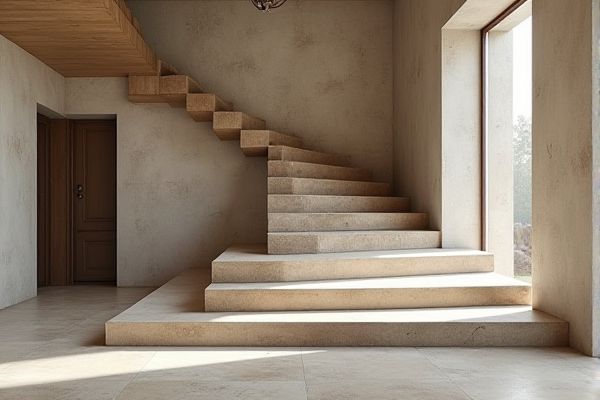
Monolithic staircases offer seamless structural integrity with a solid, single-piece construction, enhancing durability and aesthetic appeal, while prefabricated staircases provide ease of installation, cost-efficiency, and versatility by assembling pre-made components on site. Explore the rest of the article to discover which staircase type best suits your design needs and project requirements.
Table of Comparison
| Feature | Monolithic Staircase | Prefabricated Staircase |
|---|---|---|
| Construction Material | Cast-in-place concrete | Pre-made concrete, steel, or wood modules |
| Installation Time | Longer due to on-site casting | Shorter; quick assembly on site |
| Customization | Highly customizable in shape and size | Limited by standard module designs |
| Structural Strength | Excellent monolithic strength | Strong but dependent on joint connections |
| Cost | Generally higher due to labor and formwork | Cost-effective with reduced labor |
| Durability | Very durable with good longevity | Durable, but depends on material quality |
| Site Disruption | More intrusive due to casting process | Minimal site disruption |
| Maintenance | Low maintenance after curing | Depends on material; some require more upkeep |
Introduction to Monolithic and Prefabricated Staircases
Monolithic staircases are constructed on-site as a single continuous structure, offering durability and seamless integration with architectural elements. Prefabricated staircases are manufactured off-site in controlled environments, allowing for faster installation and consistent quality. Your choice depends on project timelines, customization needs, and long-term maintenance considerations.
Definition and Construction Methods
Monolithic staircases are constructed in a single, continuous pour of concrete, creating a seamless and solid structure directly on-site, which ensures high durability and custom shape flexibility. Prefabricated staircases, on the other hand, are manufactured off-site in controlled factory environments and transported for installation, allowing for faster assembly and consistent quality. Your choice depends on factors like project timeline, site conditions, and desired architectural aesthetics.
Material Options for Both Types
Monolithic staircases typically use concrete or stone, offering high durability and customization in shape and finish, while prefabricated staircases often employ steel, wood, or composite materials for faster installation and modular design. Your choice depends on the desired material properties, maintenance requirements, and aesthetic preferences, as monolithic structures provide robust, seamless construction, whereas prefabricated options allow flexibility with lightweight and varied material choices. Material innovation in prefabricated stairs includes engineered wood and corrosion-resistant metals, enhancing their appeal for modern architectural projects.
Design Flexibility and Customization
Monolithic staircases offer unmatched design flexibility, allowing for seamless integration with architectural features and bespoke shapes tailored to your space. Prefabricated staircases provide limited customization, as they are manufactured in standard designs with set dimensions, making them best suited for quick installation in typical layouts. Choosing a monolithic option empowers you to create a unique staircase that perfectly complements your interior design vision.
Installation Process and Timeline
Monolithic staircases require onsite construction involving formwork, concrete pouring, and curing, leading to longer installation timelines often spanning several days to weeks. Prefabricated staircases are manufactured offsite under controlled conditions, enabling faster onsite assembly that can be completed within hours or a few days. The streamlined installation process of prefabricated stairs minimizes labor costs and site disruption compared to the extended and labor-intensive monolithic staircase installation.
Cost Comparison: Monolithic vs Prefabricated Staircases
Monolithic staircases typically involve higher initial costs due to custom concrete pouring and extended labor time, while prefabricated staircases offer cost savings through factory production and quicker on-site installation. Your choice between the two impacts not only budget but also project timelines and long-term maintenance expenses. Prefabricated models generally reduce overall expenditure but may lack the custom design flexibility and durability of monolithic options.
Structural Integrity and Durability
Monolithic staircases, constructed in one continuous pour of concrete, offer superior structural integrity and enhanced durability due to their seamless design, which minimizes joints and potential weak points. Prefabricated staircases, while quicker to install, may present vulnerabilities at connection points and seams, potentially affecting long-term stability under heavy use or environmental stress. Your choice between the two should consider the specific load requirements and exposure conditions to ensure optimal safety and longevity.
Maintenance Requirements and Longevity
Monolithic staircases, constructed from a single poured material such as concrete, offer superior durability with minimal maintenance, often lasting several decades without significant repairs due to their solid structure. Prefabricated staircases, made from modular components like steel or wood, may require more frequent upkeep, including sealing, painting, or tightening bolts to prevent wear and degradation over time. Your choice between these options directly impacts long-term maintenance costs and the overall lifespan of your staircase installation.
Aesthetics and Visual Appeal
Monolithic staircases offer a seamless, sculptural appearance that enhances architectural elegance with their smooth, continuous surfaces and custom shapes. Prefabricated staircases provide consistent quality and quicker installation but may lack the unique visual appeal and tailored design flexibility of monolithic options. Your choice depends on whether you prioritize bespoke aesthetics or efficient, standardized construction for your space.
Choosing the Right Staircase for Your Project
Monolithic staircases offer seamless integration with the structure, providing exceptional durability and a custom fit for unique architectural designs, while prefabricated staircases excel in faster installation and cost-effectiveness due to factory production. Your choice depends on project timelines, budget constraints, and the desired aesthetic impact, with monolithic structures ideal for long-term solidity and prefabricated options suited for efficient, scalable deployment. Evaluating load requirements, space limitations, and finish preferences ensures the optimal staircase selection aligns perfectly with your construction goals.
 homyna.com
homyna.com